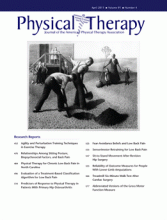Abstract
Background Use of outcome measures to examine outcomes of amputation is complicated by a number of factors, including ease of administration and lack of scientific evidence to guide selection and interpretation.
Objective The purposes of this study were: (1) to estimate test-retest reliability of a modified version of the Prosthetic Evaluation Questionnaire (PEQ), scales of a version of the 36-Item Short-Form Health Survey questionnaire adapted for the veteran population (SF-36V), the Orthotics and Prosthetics Users' Survey (OPUS), the Patient-Specific Functional Scale (PSFS), the Two-Minute Walk Test, the Six-Minute Walk Test, the Timed “Up & Go” Test, and the Amputee Mobility Predictor; (2) to calculate minimal detectable change (MDC) of each measure; and (3) to conduct item analysis of the modified PEQ.
Design This was a multi-site study with repeated measurements.
Methods Forty-four patients with unilateral lower-limb amputation participated. Participants were tested twice within 1 week. We calculated test-retest reliability of each measure using intraclass correlation coefficient (ICC [2,1]), estimated standard error of the measurement and MDC, and assessed scale score distribution.
Results The study demonstrated strong test-retest reliability scores of performance measures (ICC=.83–.97) suggesting that these measures are good choices for evaluation of people with lower-limb amputation. Reliability of PEQ subscales (ICC=.41–.93) was comparable to that reported in the literature (ICC=.56–.90).
Limitations This study examined only statistically measurable differences and did not evaluate whether changes in scores were clinically important.
Conclusions Minimal detectable change scores can be used to determine whether change in test scores exceeds measurement error associated with day-to-day variation. This is the first study to present test-retest reliability data on the self-reported OPUS scales, the PSFS in people with lower-limb amputations, and a new, easier-to-use scoring mechanism for the PEQ.
Footnotes
Dr Resnik provided concept/idea/research design, data collection, fund procurement, and institutional liaisons. Both authors provided writing, data analysis, and project management.
The authors acknowledge site principal investigators John Harris, MD, and Roy Aaron, MD; physical therapists Christina Sole-Plasa, Marcia Caetano, and Ellen Gardner; and research assistants Regina Lynch, Melanie Parent, Ryan Lantini, and Crystal Davis for their assistance with this project.
This research was supported by VA RR&D A3772C and DOD W81XWH-07-1-0689VA. The views expressed in this article are those of the authors and do not necessarily represent the views of the US Department of Veterans Affairs.
- Received August 27, 2010.
- Accepted November 21, 2010.












